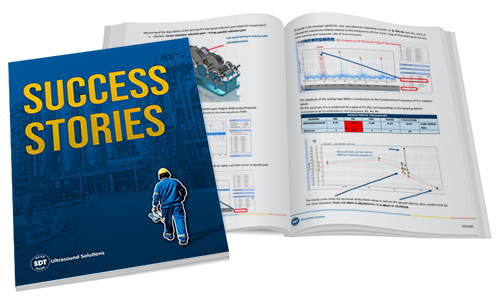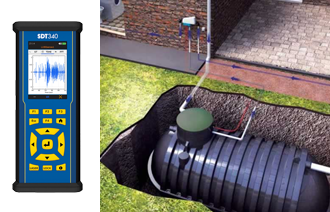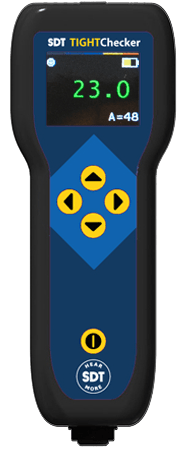Tightness Testing
When tightness integrity deteriorates, things can leak out or things can get in.
The ability to test for tightness with an ultrasound detector and its associated ultrasonic transmitter is extremely powerful and versatile.
Many things need to be airtight. Like underground storage tanks, the engine or cabin of a car, large shipping containers or the bearing housing in a paper production plant. Ensuring their tightness has positive economic and environmental effects.
Tightness testing is crucial to energy and money savings, protection from the elements and environmental friendliness.
Why use Ultrasounds?
Ultrasound capabilities lie in detecting any defect that creates friction. But what happens when there is no high pressure gas leaking through some piping? What happens when there is no turbulence? SDT has a solution for that. The sensitivity of the SDT device and the associated sensors offer the system’s unequaled accuracy.
It detects even the smallest perforations or “mini defects” not yet generating a significant degree of pollution. It allows you to locate a tightness problem, on the tank, around the manhole cover, on the pipes and on connections.
Closed Volumes Tightness Testing
Inspection Process
- Place your SDT ultrasonic transmitter inside the enclosed space and turn it on.
- Prior to sealing the space, test the decibel reading coming from the ultrasonic transmitter on the outside of the space.
- Seal the enclosed space.
- Test the outside of the enclosed space for signals coming through leaks and gaps. Using SDT340 or TIGHTChecker look for an amplitude similar to the open space value measured before it was sealed. Use HATCHecker to test marine hatch covers tightness.
- Finding such signals indicate a leak or lack of tightness integrity that needs to be tagged and repaired.
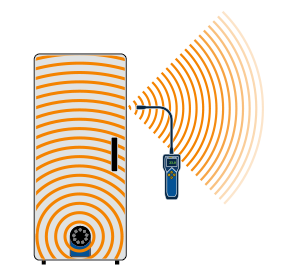
Underground Tank Tightness Testing
Since 1995 SDT has been the world leader in underground tank tightness testing. SDT developed the most comprehensive and accurate system for performing underground tank tightness inspections. A method that various accrediting agencies in Belgium, France and the United States have tested and approved. This proven method has been used to perform thousands of inspections world-wide, and over time has enabled us to develop two types of devices dedicated to different kinds of situations.
Fuel Leaking From Domestic Underground Storage Tanks Damage the Environment and Waste Valuable Resources
Over time, the tightness integrity of underground storage tanks or other air tight compartments can deteriorate. Or… they were never air tight to begin with. This is why tightness testing is an essential maintenance task to be carried out on underground storage tanks to prevent leaks that are wasteful and harmful to the environment. Indeed, leaking underground storage tanks result in contamination of the surrounding soil, groundwater and surface water. Not to mention, the loss of resources through the leak.
Underground tank testing with ultrasound simultaneously evaluates the tightness of the tank and the piping without opening the manhole. The SDT device detects leaks in domestic underground fuel storage tanks thanks to the Guided Mode embedded in its firmware, escorting you through the standard procedure step-by-step. Use guided mode to add visual information useful for report creation such as the liquid level, the tank’s diameter, and much more.
The SDT TankTest Reporter provides tank owners with a comprehensive report detailing their tank condition.
How SDT’s Underground Tank Testing Method Works
Ultrasonic tightness testing consists in collecting and amplifying the sounds generated by leaks further to the depressurization of the tank, using two sensitive sensors. With our SDT device, you can now keep track of all events during a test, thanks to a histogram that works for both sensors.
- Two dedicated sensors are placed in the tank. One in the liquid and the other one above the surface of the liquid.
- The SDT ultrasound device measures background noise in the installation (reference value) in dBµV.
- The tank is placed in a partial vacuum.
- Diagnosis is issued based on a comparison between the reference value and the measurements obtained from each sensor. You can keep track of all events during the test thanks to a histogram that works for both sensors. Check each sensor’s measurements data directly on the SDT device.
- This diagnosis is then confirmed by the operator who is listening to the sound of the leak.
- The recording time of measurement and audio files is defined based on the operator’s needs.
- Very flexible operation regarding recording time and momentary stops.
- Consultation of the dBµV values and playback of the audio files are available at any time from the device memory.
The SDT acoustic method is straightforward and provides immediate results.
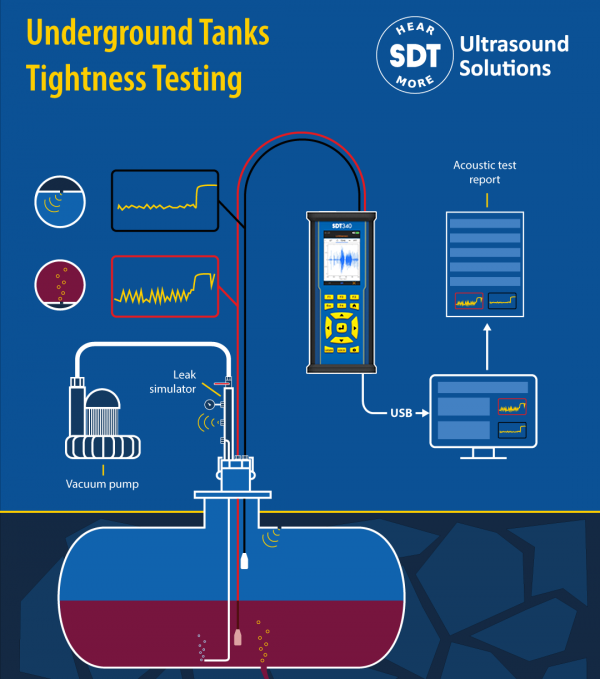
TankTest Reports
With the SDT TankTest Reporter software, you can now create simple and effective reports. These will allow you to quickly document your tanks tightness testing data and communicate them to anyone concerned in an easily accessible and understandable Microsoft Word format. This software can be installed on a Windows tablet to offer you the possibility to send your report immediately to your customer.
